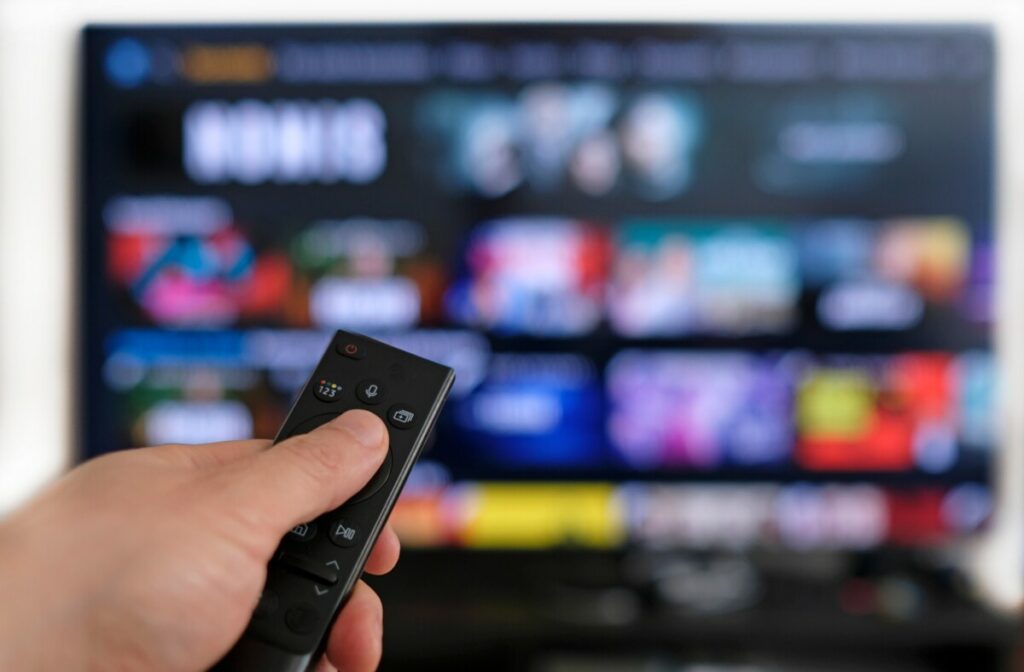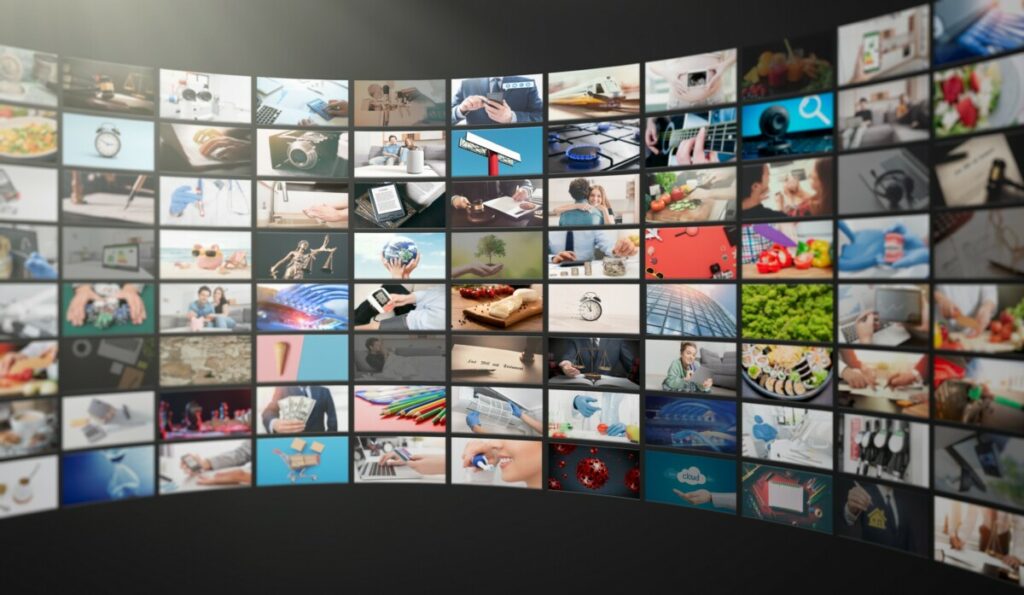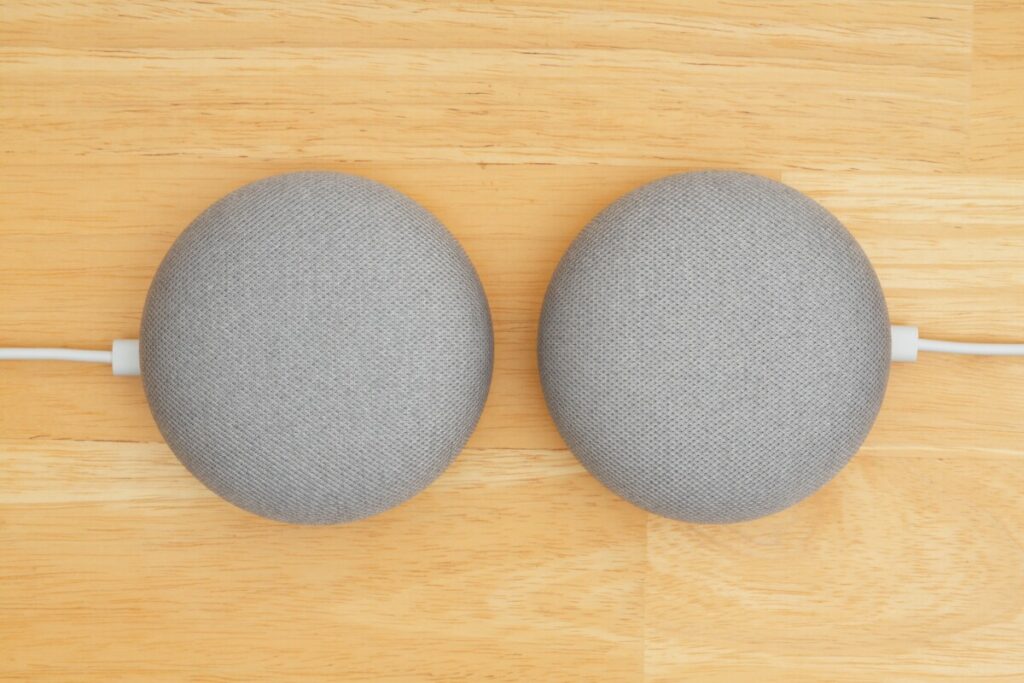- Making the Most of Your Smart Home: Common Use Cases - March 28, 2023
- Eco Mode at Night: Maximizing Nest’s Energy Savings - March 20, 2023
- Connecting & Controlling Smart Home Devices: A Guide - March 18, 2023
Disclosure: Links marked with * are Affiliate Links. As an Amazon Associate, I earn from qualifying purchases if you decide to make a purchase through these links – at no cost for you!

With modern-day technology, there are hundreds of streaming services and ways to access them. This can make it difficult to know what the best option is for you and your family to fulfill all of your viewing needs, one of the newest and most popular options today are Smart TVs.
A Smart TV has advanced capabilities such as an internet connection, voice control, and access to a variety of applications. It functions less like a traditional TV and is more user-friendly, running like a smartphone or tablet. They access streaming services, social media, music, and video games.
Clearly, Smart TVs provide great opportunities to users, but there are still a lot of questions to be answered concerning these operating systems. Are they better than regular TVs? What are the pros and cons of Smart TV systems? Read on to learn how the
Table of Contents
How is a Smart TV Different From Any Other TV?
Smart TVs are more advanced than TVs of the past. While these older models are connected to an HDTV antenna, cable, or some alternate form of A/V source, Smart TVs connect directly to your internet network like any other device that you are using in your home. This allows you access to streaming services that provide movies, music, video games, the internet, and many other media forms straight from your TV!
With a Smart TV, you can easily login to your personal or family accounts for each streaming service. You will have all of your data saved on rating, genre, and other viewing preferences. Unlike older tv models that left you scrolling through hundreds of channels to find what is playing live, you are able to start and stop movies whenever you please! Because it is connected to the internet, users are easily able to pull up YouTube, Spotify, Netflix, or nearly any other streaming service they choose, from the comfort of their own home: on the big screen.
Another reason that Smart TVs are so favorable is that they are very user-friendly. These TV systems are navigated in an almost identical manner to that of your smartphone or tablet. There is a range of apps to choose from that can be installed and accessed whenever you please! Even children are able to look at the apps on a Smart TV, recognize which ones have the shows they like to watch, and start their own movies if they want to, it is just that easy.
Many Smart TVs can also connect directly to a google home or Alexa advice, which allows one to stream videos and movies through voice control alone. Simply ask google or Alexa to start a show on the TV and you will be enjoying your choice of movie in seconds.
Do you ever have something on your phone that you wish you could just see on a bigger screen? Well, Smart TVs can take care of that desire as well! It is easy to share your phone screen with a Smart TV using the screen mirroring option. This allows you to directly connect whatever is shown on the screen of your phone and send this image to the tv, where everything you do will be “mirrored” on the big screen. This can be very helpful when showing multiple people a video, show, text, or anything else that you would like to share on your phone, but quickly and easily without sending screenshots and messages to everyone individually.
Are you tired of losing the remote and spending precious free time searching all over the house just to start a show? This is another common problem that Smart TVs have taken care of! While there are remotes available for these TVs, there is another feature that people find to be extremely helpful. With a specific app, most Smart TV providers allow you to use your phone or tablet as a remote for the television! This means that even if you lose the remote, you don’t have to waste any time pulling up your next movie or show. The connection to voice assistants also provides another way to use your Smart TV without needing a remote control to be in your hand at that exact moment.
How Does a Smart TV Connect to the Internet?
Your Smart TV is able to connect to the same internet provider that you use for the rest of your household. Just like connecting a phone, laptop, or tablet, connect to your household network through an Ethernet cable or Wi-Fi by selecting the correct information for your network name and entering the corresponding password. This will bring up a menu with tons of media applications that you can choose to access as you please.
The features and applications available will depend on the company that manufactured each Smart TV specifically. This is likely going to be either a Roku or Smart Cast of some kind. Most TLC manufactured Smart TVs will be associated with a Roku platform, while Vizio Smart TVs are more commonly connected to a Smart Cast. Essentially, both Roku and Smart Casts work the same and generally offer the same variety of applications.
In the case that you are without internet, it is still possible to enjoy some of the features provided by your Smart TV, however, they will be limited due to this lack of connection to the main power and information source of the device itself. When disconnected from the internet, access to channels provided by cable and other features provided by traditional TVs will remain available. However, you will need to maintain or establish a Bluetooth connection to do this when the internet is unavailable.
What Streaming Services Can a Smart TV Connect To?
A few of the streaming services available on Smart TVs are listed above, but really these platforms can connect to nearly any streaming service that you could want. There are options to watch sports, dramas, mysteries, romance, action, Disney, YouTube videos, podcasts, play video games, or listen to your favorite music! There are hundreds of options to choose from, but many of the most popular streaming services used on Smart TVs are listed below.
- Netflix
- Disney Plus
- Amazon Prime Video
- Spotify
- Apple TV Plus
- Hulu
- Plex
- HBO Max
- YouTube
- Pandora
- BBC iPlayer
- VUDU
- Peacock
- TED
It is highly unlikely that you will think of and want a service that is not available somehow through the applications provided somehow on your Smart TV. They can access anything that is on the internet, which is basically anything you can think of at all! Connect quickly and easily to all of your accounts by selecting the right applications on your Smart TV, and it is highly unlikely that you will be disappointed.

Does Smart TV Improve the Quality of Visual Appearance or Audio of Content?
This question has several layers, but the simple answer is that a Smart TV does not automatically have a higher quality image or audio quality than generic TV models and options. This being said, it is more likely that a Smart TV will have higher-grade audio and visual abilities simply because the Smart TV technology is newer and is more frequently used on the newest TV models that are currently being produced by manufacturers. So, while the Smart TV capabilities themselves are not the direct reason for improved sound and image production, they are generally provided with TVs that are more advanced in these areas.
Are There Other Companies That Offer Products With Smart TV Benefits?
While the internet connection, streaming services, and voice controls are all features that Smart TVs provide, there are other streaming devices on the market that have these capabilities as well. Companies such as Apple, Google, Roku, and Amazon each have their own versions of a Smart TV product available and are currently the leading brand names in the industry offering products such as the Amazon Fire TV Stick, the Chromecast with Google TV, and the Apple TV.
Each of these manufacturers offers nearly the same product, but there are some minor differences that could impact which one you would like to purchase for your home. For example, all of these options offer Spotify and Pandora to listen to music. However, only the Apple TV will allow Apple Music users to access their playlists and song preferences, because there is no iTunes App available on other platforms. A Chromecast, from Google, is especially helpful for streaming content to and from other smart devices, and also offers access to some built-in applications as well. The Amazon Fire TV Stick is one of the cheapest options for the value of the product being sold.
With all of these different options, it is important to know which aspects of a Smart TV appeal most to you and your family. Be aware of which features you intend to use the most often, research the available options, and be sure to select the one that will be best suited to your needs. The differences in price range are all accounted for within a similar range, all based on how new this specific model is and how many models have been released since.
Can a Smart TV Connect to Other Devices Like an Alexa or Google Home?
As was briefly mentioned above, your Smart TV has the ability to connect with your Amazon Alexa or Echo, Google Home or Nest, or even Apple’s Home Pod systems. This will enable voice control and activation for nearly every application or function you could potentially need on your Smart TV. These voice-control assistants have been around for several years, and the technology behind them is continuing to improve rapidly over time. However, the technology remains in the newer category and is still being applied to these products.
Currently, nearly every Smart TV manufacturer has products that are compatible with one or more of these smart assistant products released by Apple, Google, and Amazon. Samsung and LG both have Smart TVs that are compatible with both Amazon’s Alexa and Google Assistant, appealing to an even larger audience on the market. The remote controls on these Smart TVs also have a microphone button that can be used to speak a command to the assistant or television.
To set up your voice assistant in connection to your Smart TV, research pairing instructions for the manufacturer of your technological assistant and for the specific kind of Smart TV you own. This will generally lead the new user to the “voice” section within the general settings, where there will be more specific instructions on how to connect these two devices. Once connected, the two should remain connected without further issues, keeping both products, and their compatibility, very user-friendly.

Are Smart TVs Automated in Updating Software?
With such a technologically advanced culture, it can be assumed in nearly every situation that devices will, to at least some extent, update their systems automatically. This is because it is becoming more and more common for manufacturing companies to install this ability within products before releasing them. However, the speed or quality of these improvements can be reliant upon various attributes of the devices being considered.
If your TV is from a lesser-known company or is an older or smaller model, it is likely that these updates will have less of an impact on the quality of your experience, and they are likely to be updated on your TV sometime after the software update occurs on the higher-quality and newer models that are released to the public for purchase. This being said, most manufacturers are rather prompt in the release of newer updates and tend to do so periodically to maintain the speed and quality of their products and maintain or increase the satisfaction of their loyal customers. For this reason, it is also very normal for all companies to follow one another’s actions closely. When one of these big brand names comes out with a new feature, the others will not take long to follow suit and release a similar product, update, or feature in their own line of industry.
Attention: When installing electronic equipment, please be sure to observe the manufacturer’s safety instructions. You have to take care of your own safety. The information on this site only helps you to learn.
Disclosure: This website is the property of Martin Lütkemeyer and is operated by Martin Lütkemeyer. Martin Lütkemeyer is a member of the Amazon Services LLC Affiliate Program, an affiliate advertising program designed to enable Web sites to earn advertising revenue through advertising and linking to Amazon.com. Links marked with * are affiliate links.
